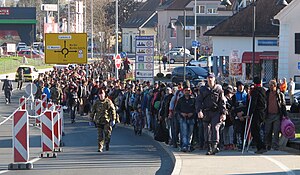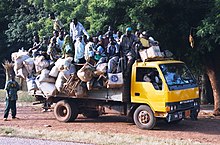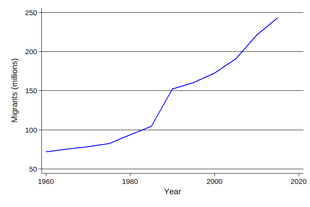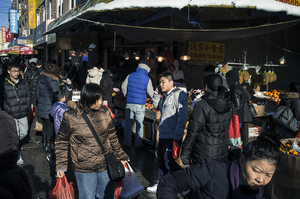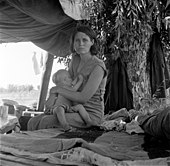
Emigration is the act of leaving a resident country or place of residence with the intent to settle elsewhere. Conversely, immigration describes the movement of people into one country from another. A migrant emigrates from their old country, and immigrates to their new country. Thus, both emigration and immigration describe migration, but from different countries' perspectives.

Human capital flight is the emigration or immigration of individuals who have received advanced training at home. The net benefits of human capital flight for the receiving country are sometimes referred to as a "brain gain" whereas the net costs for the sending country are sometimes referred to as a "brain drain". In occupations with a surplus of graduates, immigration of foreign-trained professionals can aggravate the underemployment of domestic graduates, whereas emigration from an area with a surplus of trained people leads to better opportunities for those remaining. But emigration may cause problems for the home country if the trained people are in short supply there.
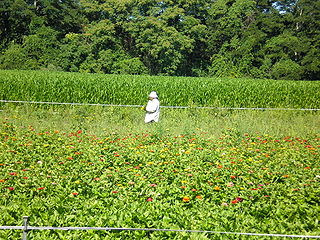
Foreign workers or guest workers are people who work in a country other than one of which they are a citizen. Some foreign workers use a guest worker program in a country with more preferred job prospects than in their home country. Guest workers are often either sent or invited to work outside their home country or have acquired a job before leaving their home country, whereas migrant workers often leave their home country without a specific job in prospect.

Free migration or open immigration is the position that people should be able to migrate to whatever country they choose with few restrictions.

A migrant worker is a person who migrates within a home country or outside it to pursue work. Migrant workers usually do not have an intention to stay permanently in the country or region in which they work.

Immigration is the international movement of people to a destination country of which they are not usual residents or where they do not possess nationality in order to settle as permanent residents. Commuters, tourists, and other short-term stays in a destination country do not fall under the definition of immigration or migration; seasonal labour immigration is sometimes included, however.
Migrant domestic workers are, according to the International Labour Organization’s Convention No. 189 and the International Organization for Migration, any persons "moving to another country or region to better their material or social conditions and improve the prospect for themselves or their family," engaged in a work relationship performing "in or for a household or households." Domestic work itself can cover a "wide range of tasks and services that vary from country to country and that can be different depending on the age, gender, ethnic background and migration status of the workers concerned." These particular workers have been identified by some academics as situated within "the rapid growth of paid domestic labor, the feminization of transnational migration, and the development of new public spheres." Prominent discussions on the topic include the status of these workers, reasons behind the pursue in this labour, recruitment and employment practices in the field, and various measures being undertaken to change the conditions of domestic work among migrants.
African immigrants in Europe are individuals residing in Europe who were born in Africa. This includes both individuals born in North Africa and Sub-Saharan Africa.
Opposition to immigration, also known as anti-immigration, is a political ideology that seeks to restrict the incoming of people from one area to another. In the modern sense, immigration refers to the entry of people from one state or territory into another state or territory in which they are not citizens in contrast, but closely correspond to emigration which refers people leaving one state or territory in which they are citizens. Illegal immigration occurs when people immigrate to a country without having official permission to do so. Opposition to immigration ranges from calls for various immigration reforms, to proposals to completely restrict immigration, to calls for repatriation of existing immigrants.
Codevelopment is a trend of thought and a development strategy in development studies which considers migrants to be a developing factor for their countries of origin.

Circular migration or repeat migration is the temporary and usually repetitive movement of a migrant worker between home and host areas, typically for the purpose of employment. It represents an established pattern of population mobility, whether cross-country or rural-urban. There are several benefits associated with this migration pattern, including gains in financial capital, human capital, and social capital. There are also costs associated with circular migration, such as brain drain, poor working conditions, forced labor, and the inability to transfer acquired skills to home economies. Socially, there are strong connections to gender, health outcomes, development, poverty, and global immigration policy.
International migration occurs when people cross state boundaries and stay in the host state for some minimum length of the time. Migration occurs for many reasons. Many people leave their home countries in order to look for economic opportunities in another country. Others migrate to be with family members who have migrated or because of political conditions in their countries. Education is another reason for international migration, as students pursue their studies abroad, although this migration is sometimes temporary, with a return to the home country after the studies are completed.

An open border is a border that enables free movement of people between jurisdictions with no restrictions on movement and is lacking substantive border control. A border may be an open border due to intentional legislation allowing free movement of people across the border, or a border may be an open border due to a lack of legal controls, a lack of adequate enforcement or adequate supervision of the border. An example of the former is the Schengen Agreement between most members of the European Economic Area. An example of the latter has been the border between Bangladesh and India, which is becoming controlled. The term "open borders" applies only to the flow of people, not the flow of goods and services, and only to borders between political jurisdictions, not to mere boundaries of privately owned property.
Angolans in Portugal form the country's second-largest group of African migrants, after Cape Verdeans. In 2006, official statistics showed 28,854 legal Angolan residents in Portugal. However, this number is likely an underestimate of the true size of the community, as it does not count people of Angolan origin who hold Portuguese citizenship. In 2022 INE counted 31,614 Angolans living in Portugal.
Return migration refers to the individual or family decision of a migrant to leave a host country and to return permanently to the country of origin. Research topics include the return migration process, motivations for returning, the experiences returnees encounter, and the impacts of return migration on both the host and the home countries.
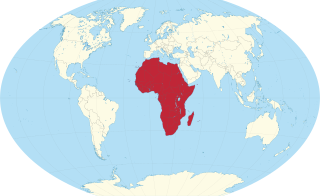
During the period of 1965 – 2021, an estimated 440,000 people per year emigrated from Africa; a total number of 17 million migrants within Africa was estimated for 2005. The figure of 0.44 million African emigrants per year pales in comparison to the annual population growth of about 2.6%, indicating that only about 2% of Africa's population growth is compensated for by emigration.
Women migrant workers from developing countries engage in paid employment in countries where they are not citizens. While women have traditionally been considered companions to their husbands in the migratory process, most adult migrant women today are employed in their own right. In 2017, of the 168 million migrant workers, over 68 million were women. The increase in proportion of women migrant workers since the early twentieth century is often referred to as the "feminization of migration".

Migrant crisis is the intense difficulty, trouble, or danger situation in the receiving state due to the movements of large groups of immigrants escaping from the conditions which negatively affected their situation at the country of origin (departure). The "crisis" situation is not the refugee numbers but the system's failure to respond in an orderly way to the government's legal obligations. Some notable crises are; European migrant crisis, English Channel migrant crisis and World War II evacuation and expulsion.

The flagship publication series of the International Organization for Migration, the World Migration Report presents data and information on human migration together with analysis of complex and emerging migration issues.
Almost half of international migrants are women, generally travelling as either migrant workers or refugees. Women migrant workers migrate from developing countries to high-income countries to engage in paid employment, typically in gendered professions such as domestic work. Because their work disproportionately takes place in private homes, they are vulnerable to exploitation and abuse. Wages earned are largely sent home to the originating country to support the cost of living of the family left behind.

